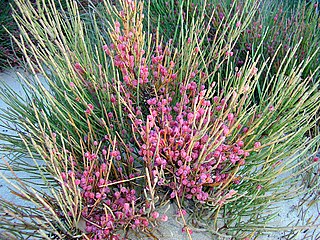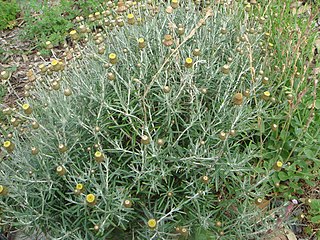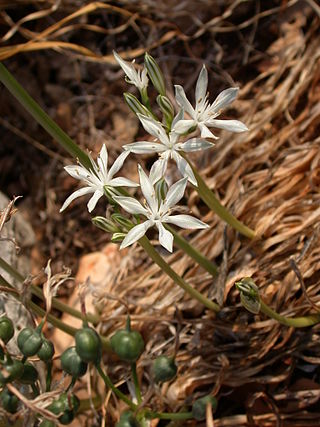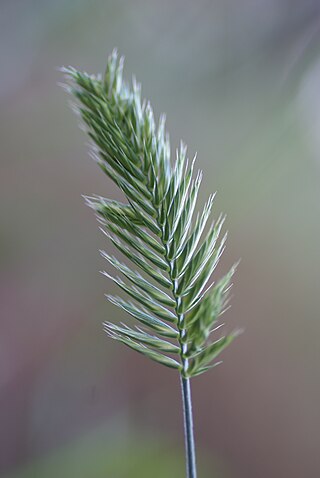
Argyrocytisus battandieri, the pineapple broom or Moroccan broom is a species of flowering plant in the legume family, Fabaceae, subfamily Faboideae. It is the only member of the genus Argyrocytisus.

Hyacinthoides is a genus of flowering plants in the family Asparagaceae, known as bluebells.

Inula is a genus of about 80 species of flowering plants in the family Asteraceae, native to Europe, Asia and Africa.
Ammoniacum or the gumammoniac is a gum-resin exuded from the several perennial herbs in the genus Ferula of the umbel family (Apiaceae). There are three types of ammoniacum: the gums ammoniac of Cyrenaica, of Persia, and of Morocco.

Rosularia is a small genus of the family Crassulaceae. It includes about 28-35 species from Europe, the Himalayas, and northern Africa.

Romulea is a genus of flowering plants in the family Iridaceae, first described as a genus in 1772. It is found in Europe, the Mediterranean, the Arabian Peninsula, and Africa.

René Charles Joseph Ernest Maire was a French botanist and mycologist. His major work was the Flore de l'Afrique du Nord in 16 volumes published posthumously in 1953. He collected plants from Algeria, Morocco, France, and Mali for the herbarium of the National Botanic Garden of Belgium.

Ephedra altissima is a species of Ephedra that is native to the western Sahara, and also to the Canary Islands.

Ephedra fragilis, commonly named the joint pine, is a species of Ephedra that is native to the western Mediterranean region of southern Europe and Northern Africa, and from Madeira and the Canary Islands in the Atlantic.
Ammochloa is a genus of Mediterranean plants in the grass family, Poaceae.

Hesperolaburnum platycarpum is a species of flowering plants in the family Fabaceae. It belongs to the subfamily Faboideae. It is the only member of the genus Hesperolaburnum. It is a tree or shrub endemic to Morocco.

Phagnalon is a genus of flowering plants in the family Asteraceae native to Europe, Asia, and North Africa.
Narduroides is a genus of Mediterranean plants in the grass family. The only known species is Narduroides salzmannii, native to Spain, France, Morocco, Algeria, Libya, Cyprus, and Turkey.
Hannonia is a genus of plants in the Amaryllis family. It contains only one known species, Hannonia hesperidum, endemic to Morocco and confined to Western Morocco, Promontory of Hercules. The specific epithet comes from Greek έσπερος, of evening, as the flowers open in the late afternoon.

Vagaria is a genus of Mediterranean plants in the Amaryllis family, widely cultivated as an ornamental because of its attractive white flowers.
Feeria is a genus of plants in the family Campanulaceae. There is only one known species, Feeria angustifolia, endemic to Morocco.

Saccocalyx is a genus of flowering plant in the family Lamiaceae, first described in 1835. It contains only one known species, Saccocalyx saturejoides, native to Morocco and Algeria.

Wangenheimia is a monotypic genus of plants in the grass family. The only known species is Wangenheimia lima.

Tulipa sylvestris, the wild tulip or woodland tulip, is a Eurasian and North African species of wild tulip, a plant in the lily family. Its native range extends from Portugal and Morocco to western China, covering most of the Mediterranean and Black Sea Basins, and Central Asia. The species is also cultivated as an ornamental and naturalized in central and northern Europe as well as a few scattered locations in North America. It was first recorded as being naturalised in Britain in the late 17th century.

Veronica repens, the Corsican speedwell or creeping speedwell, is a species of flowering plant in the family Plantaginaceae, native to Corsica and Morocco. The 'Sunshine' cultivar, whose tiny flowers are purple instead of the usual white, is recommended for rock gardens and as a ground cover.














